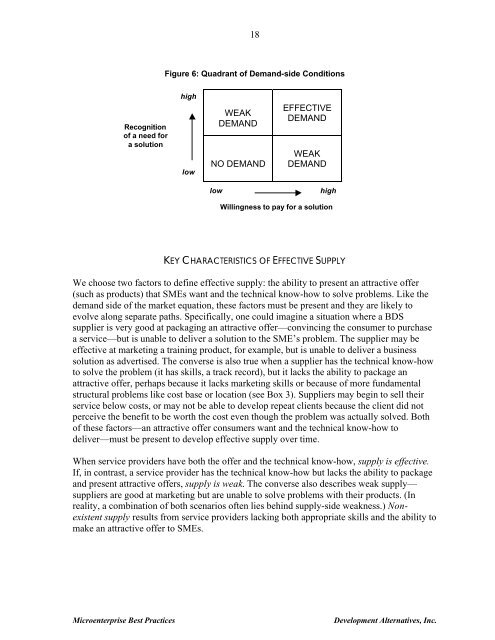BDS market development guide.pdf - PACA
BDS market development guide.pdf - PACA
BDS market development guide.pdf - PACA
You also want an ePaper? Increase the reach of your titles
YUMPU automatically turns print PDFs into web optimized ePapers that Google loves.
18<br />
Figure 6: Quadrant of Demand-side Conditions<br />
Recognition<br />
of a need for<br />
a solution<br />
high<br />
low<br />
WEAK<br />
DEMAND<br />
NO DEMAND<br />
EFFECTIVE<br />
DEMAND<br />
WEAK<br />
DEMAND<br />
low<br />
high<br />
Willingness to pay for a solution<br />
KEY CHARACTERISTICS OF EFFECTIVE SUPPLY<br />
We choose two factors to define effective supply: the ability to present an attractive offer<br />
(such as products) that SMEs want and the technical know-how to solve problems. Like the<br />
demand side of the <strong>market</strong> equation, these factors must be present and they are likely to<br />
evolve along separate paths. Specifically, one could imagine a situation where a <strong>BDS</strong><br />
supplier is very good at packaging an attractive offer—convincing the consumer to purchase<br />
a service—but is unable to deliver a solution to the SME’s problem. The supplier may be<br />
effective at <strong>market</strong>ing a training product, for example, but is unable to deliver a business<br />
solution as advertised. The converse is also true when a supplier has the technical know-how<br />
to solve the problem (it has skills, a track record), but it lacks the ability to package an<br />
attractive offer, perhaps because it lacks <strong>market</strong>ing skills or because of more fundamental<br />
structural problems like cost base or location (see Box 3). Suppliers may begin to sell their<br />
service below costs, or may not be able to develop repeat clients because the client did not<br />
perceive the benefit to be worth the cost even though the problem was actually solved. Both<br />
of these factors—an attractive offer consumers want and the technical know-how to<br />
deliver—must be present to develop effective supply over time.<br />
When service providers have both the offer and the technical know-how, supply is effective.<br />
If, in contrast, a service provider has the technical know-how but lacks the ability to package<br />
and present attractive offers, supply is weak. The converse also describes weak supply—<br />
suppliers are good at <strong>market</strong>ing but are unable to solve problems with their products. (In<br />
reality, a combination of both scenarios often lies behind supply-side weakness.) Nonexistent<br />
supply results from service providers lacking both appropriate skills and the ability to<br />
make an attractive offer to SMEs.<br />
Microenterprise Best Practices<br />
Development Alternatives, Inc.














